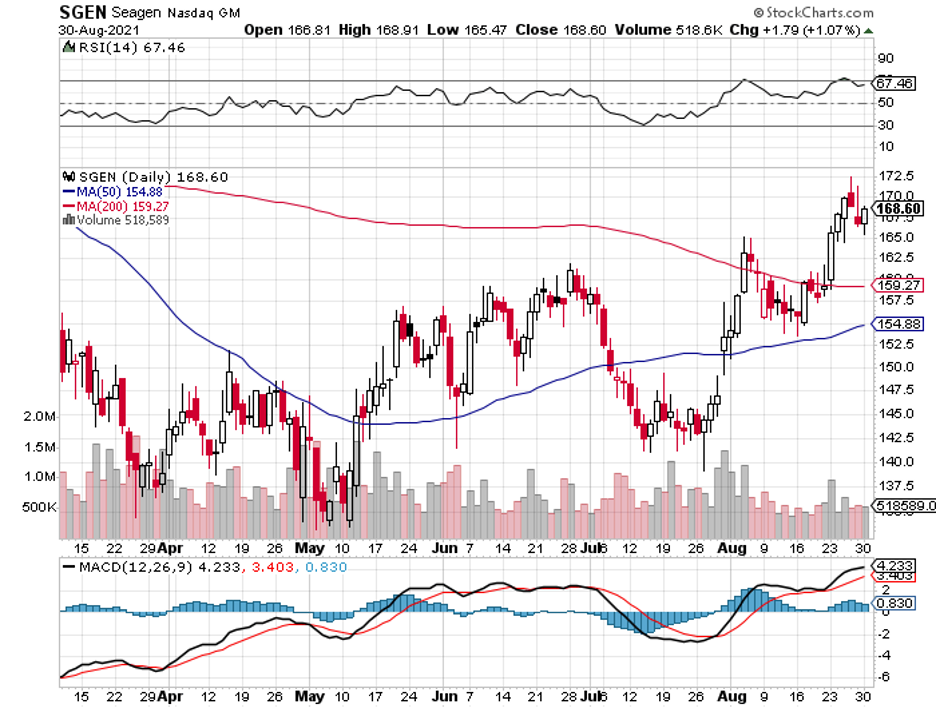When choosing a biotechnology company to invest in, a good sign to look out for is when management continuously looks for ways to expand its technology.
This means you’re looking at a stock that’s likely to appreciate multiple folds.
Seagen (SEGN) does this in spades.
Since it was founded in 1997, Seagen (SEGN) has reached almost $30.67 billion in market capitalization.
Reviewing its growth story, I think its powerful growth strategy is one of the key elements that help the company with its advancements.
That is, Seagen is aggressively developing and expanding its different labels for the approved drugs in its portfolio while also actively discovering innovative and new treatments and molecules.
Simply put, Seagen’s growth and expansion can be likened to a tree that keeps forming new additional branches.
Over the years, the company has experienced a remarkable transformation from a single-product firm to a diversified and ever-expanding player, particularly in the oncology medication market—a strategy that paid off.
After all, the market for cancer drugs isn’t the type to stand still.
This sector is renowned for its fast-paced demands and rapid growth. If you look at how much has been done, remember that several types of cancer that seemed incurable a mere 10 years ago are now no longer considered death sentences thanks to the innovative therapies discovered.
If roughly 15 years ago, the standard cancer treatment only involved chemotherapy and surgery, the recent years have granted us access to newer technologies like targeted therapy and immunotherapy.
Lately, CAR-T therapy has been hailed as the most effective means of treating blood cancer. Meanwhile, the likes of Merck’s (MRK) Keytruda and Bristol-Myers Squibb (BMY) Opdivo have made chemotherapy and surgery more effective as well.
So, it wouldn’t be a surprise anymore if the technology in the oncology sector advances further in the years to come.
Another relatively fresh innovation is the antibody-drug conjugate (ADC) technology.
This takes and combines all the positive effects of chemotherapy and targeted therapy while simultaneously eliminating the adverse effects of chemotherapy on the patient’s body.
Unlike chemotherapy, ADCs specifically target and eliminate tumor cells and works to spare the healthy ones. Once the tumor cells are detected, a toxic drug is released to kill them.
Basically, it works like a “smart bomb” in that it annihilates only the enemies and protects the allies.
The first drug to be approved based on ADCs is Mylotarg from Pfizer (PFE), which was 20 years ago.
However, it was only in recent years that this technology finally gained traction and attracted commercial success.
So far, roughly 56 pharmaceutical companies are working on developing ADCs.
Aside from Pfizer, another pioneer in ADCs is Seagen. Unlike Pfizer, this company has chosen to continue focusing on the development of the treatment.
Other companies working on ADC technology include Immunomedics, which Gilead Sciences (GILD) acquired, and Roche (RHHBY).
However, Seagen’s work looks to be the most promising in this segment.
Its first ADC drug is Adcetris, which was approved in 2011 for Hodgkin’s lymphoma and made in cooperation with Takeda Pharmaceutical (TAK).
Its indication was later expanded to cover another white blood cell disease, Peripheral T-cell lymphoma (PTCL).
Seagen already holds roughly 45% of the market share in the Hodgkin’s lymphoma segment alone, and this is expected to rise to 50% by 2026.
In terms of projected sales in the US, Adceris is estimated to generate about $1.7 billion by 2026.
On top of that, Seagen also rakes in royalties from Adceris sales outside the US thanks to its Takeda partnership.
Riding the momentum of Adceris, Seagen expanded its ADC pipeline and later gained approval for Padcev in 2019.
This drug received the go signal to treat a fairly common disease in the oncology space: metastatic bladder cancer.
In the US, the average number of new cases of metastatic bladder cancer is 83,000. Given its market size and potential to become part of a combination therapy with the ever-popular Keytruda, Padcev is expected to generate at least $2.6 billion in sales by 2026.
Gaining more confidence in its expertise in the oncology sector, Seagen continued its expansion and gained regulatory approval for breast cancer treatment Tukysa.
Tukysa is expected to bring roughly $1 billion in annual sales in the US and European markets. This figure is projected to rise when it eventually also gains approval for colorectal cancer.
Another notable drug in Seagen’s pipeline is Tisotumab Vedotin (TV), which is a collaboration with Genmab (GMAB). TV is a cervical cancer treatment and is expected to gain approval by the end of 2021.
Shifting gears, let’s take a look at the upcoming growth of Seagen. Initially, its 2021 guidance put its annual sales at $1.28 billion for all the products.
However, Seagen has already exceeded expectations, with Adceris reporting $700 million in sales for a single quarter this year. Actually, both Adceris and Padcev are well on their way into becoming blockbusters in a year or two, thanks to their continuously expanding applications.
Overall, Seagen is an excellent long-term investment.
Aside from its work with giant biopharmaceutical companies like Merck and BMY, its current portfolio of treatments and pipeline programs present a myriad of opportunities for Seagen.
Moreover, its ability to develop powerful treatments and leverage the science of ADCs make Seagen one of the most promising oncology stocks in the market today.


